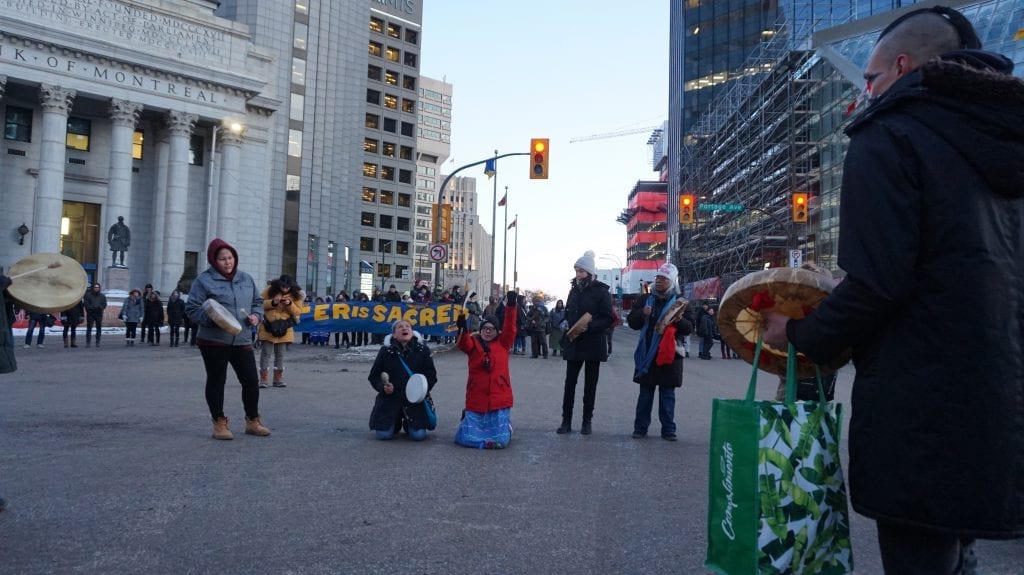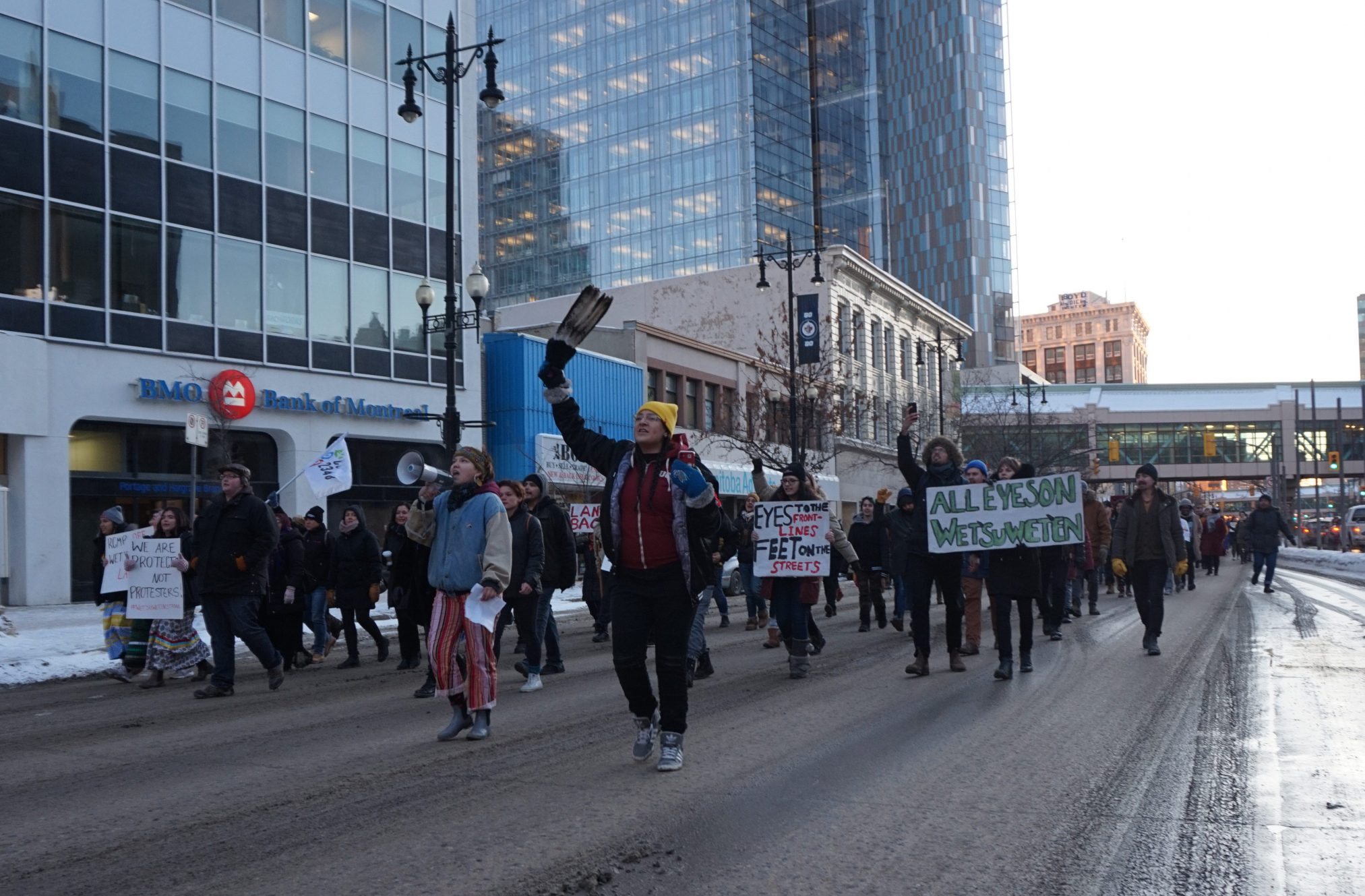On Monday night, in the middle of Winnipeg’s busiest intersection, Sadie-Phoenix Lavoie, who is two-spirit Anishinaabe, shouted into a megaphone: “I was watching Wet’suwet’en today. I wanted to cry so much and so hard. We will stand up and fight back.”
Next to Lavoie, two women knelt in the middle of the road while drummers played and sang and hundreds of supporters danced in a circle around them. Similar acts of solidarity took place nearby, simultaneously shutting down three of the city’s busiest intersections at the height of rush hour.
You may unsubscribe from any of our newsletters at any time.
It felt like a furious and cathartic unleashing of emotions, but this week has been one of fury, heartbreak and courage across this land some call Canada.

Days earlier, I had shed tears as I watched on social media while RCMP made arrests on Wet’suwet’en territory.
Last Thursday, police, acting on a court injunction, began a pre-dawn raid along a remote logging road in northwestern B.C. Their target was the first of three encampments established by Wet’suwet’en land defenders in defiance of a liquid natural gas pipeline slated to be built across their unceded territory.
Some Wet’suwet’en elected chiefs and councils have signed agreements with Coastal Gaslink, the company building the pipeline. However, hereditary leaders, who hold title to their traditional territory, an area much larger than the reserve lands governed by elected governments, have unanimously rejected it.
More on Broadview: Electricity comes with a devastating cost for Indigenous communities
Under cover of darkness on Thursday, RCMP, supported by tactical teams in military gear, police dogs, and drones with infrared sensors advanced on the first of the Wet’suwet’en checkpoints and began arresting the occupants.
Police reached a second outpost on Friday and took more land defenders into custody.
On Saturday, two helicopters touched down at the third encampment. Wet’suwet’en clan matriarch Freda Huson was ready for them, dressed in her regalia and performing ceremony, drumming and singing, The Tyee reported. She refused to speak to the police, who left a copy of the injunction. Later, Huson threw the injunction into a fire. “They tore down our traps. They’ve disrespected my chiefs,” she said. “So that is why it comes to this. Why we have a cremation ceremony for Canada.”
Two days later, Huson and other occupants of the encampment were arrested. A powerful photo taken by a camp supporter swiftly circulated on social media: On a bridge lined with red dresses representing missing and murdered Indigenous women, police used a chainsaw to cut through a wooden gate painted with the word “reconciliation.”
11:01 am – RCMP dismantling gate on the bridge.
6 arrests, including Freda Huson. #AllEyesOnUnistoten #AllEyesOnWetsuweten #WetsuwetenStrong #ReconciliationIsDead #shutdowncanada #unistoten #landback #thetimeisnow pic.twitter.com/TAa2BYKnSi— Unist'ot'en Camp (@UnistotenCamp) February 10, 2020
The anger unleashed by these scenes has poured into the streets in cities across Canada, over railroad tracks, and onto the steps of legislative buildings. In Montreal, Ottawa and Toronto, protesters have blocked rail lines, leading to the cancellation of countless freight and passenger trains.
As the environmental chaos we’ve long seen coming begins to unfold in real time, I often feel like I’m teetering on the edge of an abyss of grief. What gives me courage is witnessing a generation of young leaders stepping up to meet this crisis with passion and resolve.
Last week, I was with a group of young people—some still in high school—who walked into the Winnipeg office of MP Dan Vandal, minister of northern affairs, and vowed to stay there until he publicly denounced the RCMP invasion of Wet’suwet’en territory.
As I coordinated media interviews for the group, I saw two young Indigenous women, 20-year-old Emily Amos and 19-year-old Bianca Ballantyne, take centre stage and speak with eloquence and passion. The colonial state will have these two and others like them to reckon with in the years ahead.
After six nights of sleeping on the thinly carpeted floor of Vandal’s office, Amos, wearing a denim jacket with the word “Land Back” painted onto it, led the march down Portage Avenue wielding a megaphone and calling out: “No justice, no peace, no racist police.”
In an interview, Amos said that Indigenous youth are the ones putting their bodies on the front lines of the struggle, but they’re doing so with the guidance of their elders. Their actions are surrounded by song, ceremony, prayer and teachings. Right now, a sacred fire is burning in front of Vandal’s office; others like it are alight across the country.
Broadview is an award-winning progressive Christian magazine, featuring stories about spirituality, justice and ethical living. For more of our content, subscribe to the magazine today.















Mr. Neufeld paints a narrative of David vs Goliath proportions. The problem is that it is not an accurate representation of the facts. He does not need to answer to me except that I am a reader trying to looking for all the facts to discern what is really going on. I come across countless articles with First Nation people who support the pipeline. The latest was an interview by the CBC a few days ago with a Wet’suwet’en woman by the name of Bonnie George, She said this: “There’s quite a bit of support for this project. But people are afraid to speak up because, in the past few years, people that [have] spoken up were either ostracized … ridiculed, bullied, harassed, threatened, and being called a traitor — a sellout”. Mr. Neufeld, please explain this to your readers. Thank you.
Thanks for your questions. This article might help answer some of them: https://www.macleans.ca/opinion/the-wetsuweten-are-more-united-than-pipeline-backers-want-you-to-think/
Of course there is a range of perspectives on any contentious issue. But for everyone who cares to know the truth the Hereditary leaders themselves were split on the issue. As the globe and mail and other studies on this indicate female hereditary members have been removed from their positions for supporting the agreement. The women claim that their authority has been usurped and that the Office of the Wet’suwet’en Nation – the non-profit entity that co-ordinates and represents the hereditary governance system – has violated traditional protocols and decision-making processes. And as also reported one of the five five hereditary chiefs who has led the opposition to the project only assumed his hereditary title after it was stripped from his predecessor, Gloria George, for her support of Coastal GasLink. No sir, you make this sound like some sort of romantic struggle of what – native against the rest of us. When that is clearly not the case. The case is that most legitimate representatives of First Nations support prudent economic development of natural resources. That’s the encouraging story here.
My lack of sympathy occurs when I see supporters blocking rail lines, sabotaging bridges, and disrupting commuters.
Did the FN vote on this? Was there a consensus? Flip-flopping a decision to gain political opinion agitates the majority of us. (If hereditary leaders have an issue with the chief’s decision, take it up with them)
Compiling social issues (red dresses) makes me think you have nothing else to do but complain.
First – I’ve always been for reconciliation in general. But for pipelines -can someone tell me who should be negotiated with here? The elected councils, the hereditary chiefs or ?? It seems someone is ‘playing’ another – are the chiefs playing the councils, are the councils playing the government ? or is the government playing the electorate? All of the above? Stop the waste! -of goodwill, $$, patience, and the economy.
Unfortunately a few loud opponents of the pipeline are getting all the attention and we aren’t hearing from all the other First Nations people (including Wet’suwet’en people) who are in support of the pipeline. That’s partly the fault of the media that don’t always present both sides as well as people who are afraid to speak up for fear of retaliation.
The saddest part is that protesters hold the whole country hostage by blocking both passenger trains and freight trains. They endanger lives since propane for heating and chlorine for safe drinking water travel to many communities by train. Grain farmers and many other businesses are losing money. It’s an illegal blockade and very destructive to the country.
Wet’suwet’en elected chiefs and councils have signed agreements with Coastal Gaslink, the company building the pipeline. However, hereditary leaders, who hold title to their traditional territory, an area much larger than the reserve lands governed by elected governments, have unanimously rejected it.
Here is the sticking point for me. There are injunctions in place; blocking rail lines is dangerous and breaks laws. Canada is a country with rule by law – not mob. I would not choose it any other way. The provincial and the federal governments also need to work in tandem to find solutions (compromises!). It is complicated. The fact is that the hereditary leaders have NOT even managed to convince their own elected officials and councils. It is extremely complicated; take care not to simplify it.
Every generation comes with its cause. A cause encouraging the present generation, in power, to look and see what is going on that is wrong. There will always be causes/issues to be dealt with. It is how we respond and engage with one another which is important. Are we in respectful communication? Are we listening to one another? Getting it wrong leads to destruction, however getting it right will leads to life, peace and understanding.